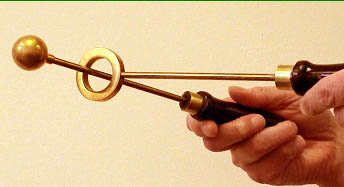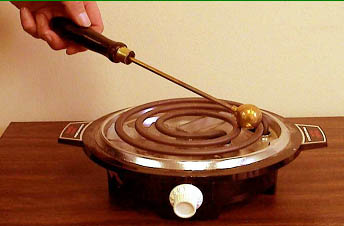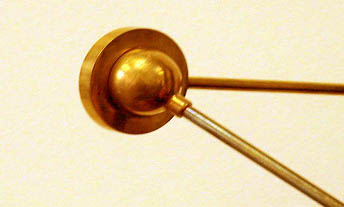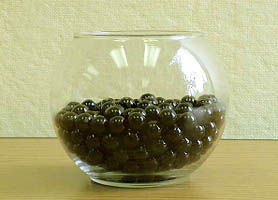Density Curriculum
Section 3—Lesson 12: Can the Density of Solids, Liquids, and Gases Change?
Lesson Plan
Materials
- A brass ball and brass ring with heat resistant handles
- Heat source (such as a hot plate) for the demonstration
- Student white boards
- Model of 2 balls and a spring
- Student journals
- Bowl of marbles
- Glass filled with water
- Cause #1, Cause #2, and Cause #3 posters (PDFs)
- How do Molecules Move? sheet (PDF 101 KB)
- Reflecting on What You've Learned about Changes in Density (PDF 70 KB) sheet
Prep Step
- Review the lesson plan, background information, and understanding goals.
- Gather materials.
- Photocopy the sheets: How do Molecules Move? and Reflecting on What You've Learned about Changes in Density.
Analyze Thinking
Step 1: How Do Molecules Move?
1) Have the students read the sheet How do Molecules Move?. This short paper is written by a scientist who specializes in chemistry. It explains the differences between solids, liquids and gases at a microscopic level.
2) Ask the following questions:
- What are the major points of the article? That is, what does the scientist want you to understand?
- What makes sense about the article? Give specific details.
- What does not make sense about the article? Give specific details.
Step 2: Can Density Change?
Pose the question, "Can density change?" Accept whatever answers students offer, as long as they back them up with reasoning and evidence from examples that they can think of.
RECAST Thinking
Step 3: Discrepant Event: Ball and Ring Demonstration
Show the students the ball and ring. Calculate the mass of the ball (including the handle). Pass the ball through the ring at room temperature to show the students that the ball will easily pass through the ring. Heat the ball (for 5 minutes on a hot plate set to 'high') and try to pass it through the ring. The ball increases in volume and will not pass through the ring. Again, measure the mass of the ball with the handle. It does not change from the first measurement.
| Ball and Ring Demonstration |
 |
 |
 |
Have the students discuss what they just witnessed. What happened when you heated the ball? Why won't it go through the ring now? What do they think is going on?
Ask the following questions:
- When does the density of an object change?
- Why does density of an object change?
- How does the density of an object change?
- Did the brass ball get more dense or less dense when we heated it?
- What could you do to make an object less dense?
- What could you do to make an object more dense?
- What would it look like if it were magnified thousands of times?
Step 4: Drawing Models of the Ball and Ring Demonstration
Have students draw models on their white boards to explain what happened and why they think it happened. Circulate while students are working. Choose three or four interesting explanations and have those students explain them to the class. In choosing which ones to present, try to choose examples where students have tried to reason from what they know about the nature of matter. It would be good to include a few where the student has an answer that does not match the scientifically accepted response but has done some interesting thinking.
Explore Causality
Step 5: Analyzing the Ball and Ring Demonstration in Terms of the Three Causes
Make sure that Cause #1, Cause #2, and Cause #3 posters are up for reference. Remind the students to think about the causes of density and draw their attention back to the posters.
Guide students to a scientifically accepted model of what is happening in the ball and ring relationship and contrast it to the models that they came up with. Explain, "If the density is changing, then the cause of density must be affected in some way. Is it possible that any of these things could change?"
- Number of protons and neutrons—i.e. the mass of the atoms?
- The strength or structure of bonds?
- Whether the density is mixed or not? (and in the case of air, how spread out the molecules are?)
Have students discuss what they think could be going on. What do they think changes when you heat the ball and ring?
Ask, in the case of the ball and ring:- Do the mass of the atoms themselves change? [No.]
- Do the bonds change when you heat them? [Yes.] Show a model of bonded atoms made out of two balls and a spring. Discuss how bonds have some springy-ness to them. Show two different bonds with different strengths. Show how each can vibrate or move to expand.
- Does the crystal structure change? [No, not unless it is heated to the point where it is becoming a liquid. This depends on what the substance is. Metals will not melt under these temperatures, only under very high temperatures. Other things will melt, for instance, chocolate.]
In a solid, the movement of the atoms and/or molecules is described as 'vibration' and they remain in the same position relative to the other atoms and molecules. The cause of the expansion has to do with the bonds between atoms and the vibration of the structures.
Step 6: Introducing a Puzzle
If the density is changing, how can it be that every element has a numeric density assigned to it? What do students think about that? Gather their ideas.
Explain that the numeric value is an average and has to do with the density under certain conditions. While density can change, we think of it as a property of matter. However, textbooks that just state, "Density cannot change" are misleading!
Step 7: What Happens to the Density When Liquids and Gases Are Heated?

We know now that the density of solids can change when certain conditions change. What about liquids and gases? Start by discussing liquids. Show students a bowl full or marbles and demonstrate how they roll around each other.
Ask the students to visualize molecules heating up and bouncing off of each other. Ask the students to imagine that the marbles are bouncing off of each other. Show students a glass full of water filled to the top and sealed. What do they think would happen to the water if we heated it? [It would expand.]
Note to Teacher: Students often bring up the issue of ice expanding as it freezes. Explain that water/ice is not a good example to reason from because it doesn't follow all of the same rules as other liquids. When water freezes or crystallizes, it takes on a structure that incorporates little pockets of empty space, like a honeycomb. When the structure melts, the little pockets collapse and the liquid occupies less volume. The little pockets are full of vacuum, not air (this is a common misconception) although most ice does sometimes trap little bubbles of air when it freezes. Water is not confusing as an example to reason from when thinking about what happens during the transition from liquid to gas. Encourage students to focus on other liquids that they know about. Most things contract when they get colder. Use wax or chocolate as examples.
Explain that as the liquid molecules bounce off of each other, some may eventually change phase and become a gas. Have the students think about a pot of water as it starts to boil. What is going on? The molecules are moving or bouncing around so much that some of the molecular bonds between them break and they become gas molecules. On the board, draw a diagram of water molecules as a gas. What is in between them? [Air. Air is composed of a mixture of gases, mainly nitrogen, oxygen and carbon dioxide. "Molecules of air" or "air molecules" refer to any of the different kinds of molecules found in air.]
Water expands when heated, but it has a specific density. What is going on? Discuss what the students think is happening. Remind them that even though we assign numbers to densities (for liquids as well as solids), they still can change.
Step 8: Drawing Models of What Happens When Liquids and Gases Are Heated
Have students draw models on their white boards of a fluid (liquid or a gas) expanding. They should show the fluid two times before it is heated and after it is heated. Circulate while students are working. Choose three or four interesting models and have those students explain them to the class. In choosing which ones to present, try to choose examples where students have tried to reason from what they know about the nature of matter. It would be good to include a few where the student has an answer that does not match the scientifically accepted response but has done some interesting thinking.
Discuss the students' models. Contrast them to the scientifically accepted explanation. Incorporate the following information as is relevant. Do not worry about including all of these points. This is intended as supporting information:
- For gases, the major source of density is Cause #3—what other gases are in between the gas molecules in question and how spread out the atoms or molecules are (even though their atoms weigh different amounts and some of them are more than one atom bonded together). However, when you are comparing different gases, the difference in the mass of their atoms makes a difference in which gases sink in relation to others. When a gas is spread out there can be other kinds of atoms and molecules in between—such as nitrogen, oxygen, and water.
- Gases can expand a lot because they are typically alone as atoms or molecules. The major reason for changes in density is how spread out the molecules is because the mass of each atom doesn't change and there aren't really bonds to worry about.
- For liquids, the atoms don't change mass and scientists aren't really sure how to think about the bonds, but we know that the atoms or molecules vibrate, and so they can get further apart. There isn't air in between the atoms or molecules. (When there is, such as in carbonated soda or in water when it boils, it is a mixed density.)
- For solids, the atoms don't change mass, but the bonds between them stretch like a spring. The atoms can get as far apart as the "springy-ness" of the bonds can stretch, but they can't become more spread-out than the distance the bonds will allow.
- Liquid molecules are not necessarily "more spread out" (less dense) than solids.
Review, Extend, Apply
Step 9: Assessing Our Own Understanding
Hand out the sheet, Reflecting on What You've Learned about Changes in Density. This sheet asks students to reflect on their own learning in terms of what they understand, what they find plausible, and what they actually believe about changes in density.


